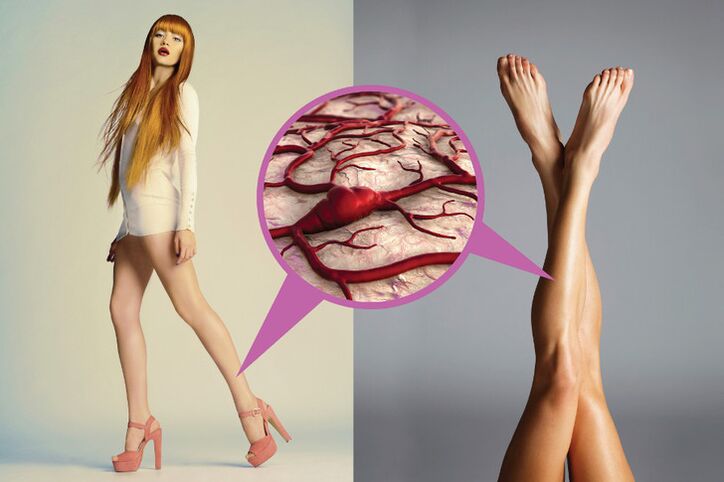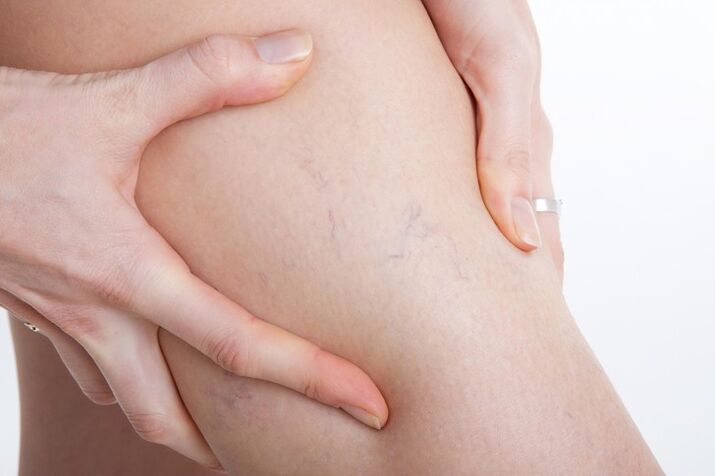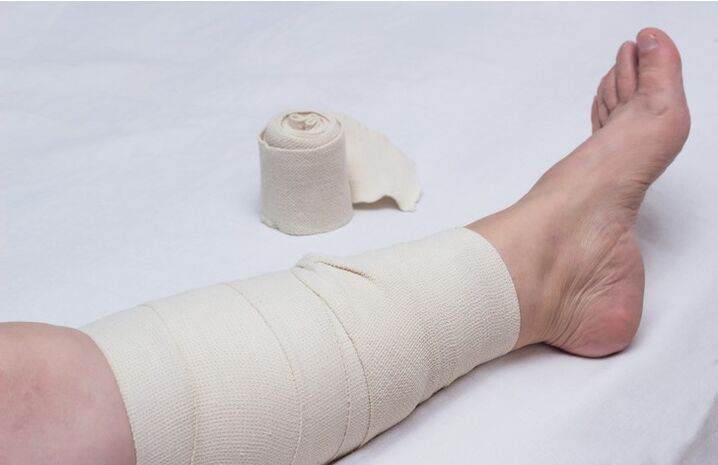Every woman wants her legs to always be in great shape. But what if one day, standing in front of the mirror, you would discover that your feet were covered with non-sympathetic vascular "stars"? Masking will not work. It is impossible to ignore, as further these "decorations" will only become brighter and larger. Fighting varicose veins of the lower extremities, although not easy, is necessary. After all, you have to agree that wearing pants forever is not the most tempting prospect.

Varicose veins in the legs are a serious condition in which the veins lose their elasticity, stretch, dilate and bend.
Varicose veins in the legs have long been known as a serious disease. In general, in such a not so pleasant way, we pay for the opportunity to walk on two legs. The influence of various unfavorable factors leads to weakening of the venous walls and stagnation of blood in the lower half of the body.
As a result, the vessels are overloaded, and the venous valves are working worse and worse. The result - the feet get tired, hurt, there is a feeling of heaviness, the feet and ankles swell. A little later, other symptoms add up in the form of cosmetic imperfections. In the future, more serious complications are possible.
Previously, it was believed that varicose veins in the legs - a disease of people of professions "on foot", and the first symptoms appear about 35 years. This is partly true. But today varicose veins are becoming newer. It can be said that the disease has already become a problem for the 20-30-year-old "computer generation".
Unfortunately, there are no clearly pronounced symptoms of approaching varicose veins in the legs. But if your feet start to hurt and get tired, a weight appears on your feet and you suffer from convulsions - this is a reason to be on your guard.
And the appearance of barely visible bluish veins known to many - vascular networks, which later, if left untreated, will become more visible - is a signal for action. It is worth sounding the alarm when whole groups of saphenous veins have already appeared on the surface of the feet, because the result of the disease are ugly blood clots and ulcers, which are very difficult to fight. Treatment of varicose veins in the legs can take decades.
The most dangerous consequence of varicose veins is the development of thrombophlebitis - the formation of a blood clot in a vein.
The inflammatory process that accompanies the disease creates the risk of a thrombus that removes the vessel wall. And this, in turn, can lead to the development of pulmonary embolism, when a thrombus enters the vessels of the lungs, partially or completely disrupting the functioning of the respiratory system. And it can even lead to death.

Varicose veins in the legs: and it threatens me?
Unfortunately, it is difficult to name the exact cause of the appearance of varicose veins in the legs. This disease is a consequence of various factors. And each of us faces some of them every day.
Reason 1. Inheritance
Phlebologists say varicose veins are a "familial" disease. If a mother or grandmother suffered from this disease, then in 90 percent of 100 it can be argued that you are at risk. Through genes, the features of the structure of blood vessels are transmitted to us. And if the walls of the veins are weak, then the influence of any of the provocative factors is enough for the disease to become felt.
Reason 2. Pregnancy
Carrying a baby is one of the most important provocative factors in the development of varicose veins, as changes in hormonal levels lead to a decrease in venous tone. In addition, during pregnancy, the veins are almost always compressed by the growing uterus. Plus, the weight increases. But our veins experience the greatest pressure during childbirth. According to statistics, in 50 percent of women, getting varicose veins earlier manifests itself at this particular time.
Reason 3. Uncomfortable clothes and shoes
Uncomfortable and tight clothing, such as skinny jeans, can cause varicose veins. No less harmful are tight shoes and high heels. The wider the heel of the boots, the less stress on the foot. By balancing thin stilettos, we subject our veins to a large load. And if you also carry heavy grocery bags in your hands, then you can say goodbye to beautiful legs forever.
Reason 4. Working conditions and bad habits
Do not forget about the people who keep the classic professions "on foot" (salesmen, waiters, hairdressers, stewardesses and many others). They have varicose veins - almost an occupational disease. An entire army of office workers is approaching them, as any prolonged stay in one position (even sitting, even standing) does its dirty deed. And if you add to this bad habits like smoking, eating buns and sandwiches, which leads to excess weight, then varicose veins will not keep you waiting. Yes, of course, this includes the love of many people to sit cross-legged.
Reason 5. Sports overload
Not all gyms are good. Lovers of drinking grass in the gym are in serious danger. Weight gain is one of the causes of varicose veins. If you have a predisposition to varicose veins, you should not overload your legs with excessive exercise. Strength training and martial arts lessons are not for you.

Diagnosis and treatment of varicose veins
As it is already clear, varicose veins in the legs are not a cosmetic defect, therefore, with the appearance of the first unpleasant sensations in the legs, you should immediately consult a phlebologist.
If necessary, the doctor may prescribe Doppler ultrasound, which will determine the quality of blood flow in the vessels and show if there is any obstruction to it, and transillumination - transillumination of superficial veins using a special light, ewhich allows the specialist to easily distinguish a damaged vein from the normal one. These necessary measures will make it possible to identify the initial disease in time and take the necessary measures in a timely manner.
If we talk about treating varicose veins, then modern medicine knows several ways to deal with varicose veins:
- Local remedies (ointments, gels):relieve fatigue and feeling of heaviness in the legs, have a pleasant calming effect. This method of treatment will not bring immediate relief, as the active substance penetrates the skin in small doses. The beneficial effect is only on the superficial saphenous veins. However, with regular use, oils and gels can correct the situation in the initial stage of varicose veins in the legs.
- Venotonics:medicines used for venous insufficiency (prescribed only by a doctor). These medications help reduce swelling, relieve leg pain, and also strengthen blood vessel walls and improve blood circulation. Venotonics perfectly complement the action of local remedies to achieve maximum effect in the treatment of deep veins.
- Endovasal laser coagulation (EVLK):a method of treating vascular "stars" and "nets", precursors of varicose veins in the legs. The doctor operates on the diseased vessel with a laser and the "star" disappears. The procedure is performed under local anesthesia. After a couple of weeks, there is no memory of manipulation on the skin.
- Sclerotherapy:a procedure where substances - sclerosants - are injected into a problem vein with a syringe, and the affected vein appears to stick together from the inside and stops working, and blood begins to flow through the healthy veins. But this procedure is not suitable for everyone. It is described if the nodes are not too large.
- Ozone therapy:a new method of treating varicose veins, which is used to eliminate spider veins. Ozone is injected with a small needle directly into the lumen of the vessel and makes it stick together. To achieve a noticeable effect, a few procedures are enough.
- Phlebectomy:surgical intervention, when the diseased vein is removed, is one of the most effective methods of treatment. One day after surgery, you can go home, but for at least another month you should wear special tights or tie your leg. During the operation, small drills are made in the foot, which after a while are almost invisible.
It is widely believed that hirudotherapy or the treatment of varicose veins with caterpillars helps to get rid of varicose veins in the legs. In fact, the substance that caterpillars secrete when bitten, hirudin, helps reduce blood clotting. Neither spider veins nor veins disappear anywhere. Moreover, ulcers can form at the site of the bite, which are then difficult to cure.
Prevention is the best treatment for varicose veins: 5 steps to vein health
A healthy lifestyle is the best way to say no to varicose veins and many other diseases!
Step 1. Movement is life
Swimming is a kind of universal physical activity, practically without contraindications. Water treatments are most suitable for preventing varicose veins, as they tone the blood vessels well. Walking is also a good way to fight venous diseases. For example, on an escalator or ladder. No heavy bags, please. It is better to walk two stops on the subway than to go by transport. And at home you can do the most basic "bike" exercise in the supine position.
Step 2. Elegant helper
Modern knitted compression garments: knees and tights will help against fatigue and heaviness in the legs. They are sold in pharmacies and are strictly selected individually by the doctor based on the foot parameters. In appearance, medical sweaters are no less beautiful and fashionable than the usual ones. In addition, they help ships better withstand the added load.
Step 3. Delicious and healthy
First, excess weight puts a serious strain on blood vessels. So if you have a few unnecessary pounds, then it is better to remove them. Second, food to prevent varicose veins should aim to strengthen the walls of blood vessels. This is facilitated by vitamins such as ascorbic acid and routine contained in sea buckthorn, raspberries, citrus fruits, chokeberry, strawberries, ash hips. And common buckwheat is rich in natural antioxidant quercetin, which not only strengthens blood vessels, but also has anti-cancer properties.
Step 4. Beauty without sacrifice
Comfortable shoes with heels no higher than 4 centimeters are the best choice for every day. In high-heeled shoes, the foot is in a forced bent position, as a result, the feeding of the small vessels of the toes is disturbed, venous congestion occurs, swelling in the ankle and calves.
Step 5. Care and maintenance
To prevent varicose veins in the legs, it is helpful to rinse the feet with cold water after a shower. You can do a massage yourself: stroke the movements from the bottom up from the foot to the groin. Overheating is dangerous for the veins, therefore, if there is a predisposition to varicose veins in the legs, it is better to exclude the bath and sauna from your life. And also do not overdo it with sunlight. Ultraviolet light reduces the elasticity of tissues and venous walls, and leads to varicose veins. You can sunbathe, but not at noon, but until 11 in the morning and after 5 in the afternoon.
Yes, varicose veins in the legs are a chronic condition. However, timely prevention of varicose veins will help avoid the onset of the disease and reduce the risk of developing possible complications.























